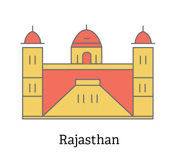 Discover Rajasthan - Culture, Food, Attractions and Key Facts
Discover Rajasthan - Culture, Food, Attractions and Key FactsCapital - Jaipur
No. of Districts - 50
Population - 68,548,437
Area - 342,238 sqkm
Pop. Density - 201/km2 (520/sq mi)
GDP - 11.33 lakh crore (US$160 billion)
Literacy Rate - 66.1%
Gender Ratio - 928
Official Website - https://rajasthan.gov.in/Pages/default.aspx
Here are some key facts about Rajasthan:
Location: Rajasthan is a state located in the northwestern part of India. It shares borders with Punjab, Haryana, Uttar Pradesh, Madhya Pradesh, Gujarat, and the country of Pakistan.
Capital: The capital city of Rajasthan is Jaipur, which is also known as the "Pink City" due to the dominant color of its buildings.
Area and Population: Rajasthan is the largest state in India by area, covering approximately 342,239 square kilometers (132,139 square miles). As of the last available data, it has a population of over 70 million people, making it the seventh most populous state in India.
Language and Culture: The predominant language spoken in Rajasthan is Rajasthani, although Hindi is also widely spoken and understood. Rajasthan is famous for its rich cultural heritage, including its colorful festivals, traditional music and dance forms like Ghoomar and Kalbelia, and vibrant art and crafts, such as pottery, block printing, and tie-dye textiles.
Tourist Attractions: Rajasthan is a popular tourist destination known for its majestic forts, opulent palaces, and intricately designed temples. Some of its famous attractions include the Amber Fort, Mehrangarh Fort, City Palace Jaipur, Udaipur City Palace, Jaisalmer Fort, Hawa Mahal, and the Jain Temples at Ranakpur and Dilwara.
Thar Desert: A significant portion of Rajasthan is covered by the Thar Desert, also known as the Great Indian Desert, which is one of the largest deserts in the world. Despite its arid landscape, the region supports a diverse range of flora and fauna, including several species of wildlife adapted to desert conditions.
Economy: Agriculture and tourism are two of the main sectors driving the economy of Rajasthan. The state is known for its production of crops such as wheat, barley, pulses, and oilseeds. Additionally, Rajasthan has rich mineral resources, including gypsum, limestone, and marble, which contribute to its economy.
History: Rajasthan has a rich historical legacy, with numerous kingdoms and dynasties having ruled over the region throughout its history. It was formerly known as Rajputana, named after the warrior clans called Rajputs who established many princely states in the area. The state has witnessed significant historical events and battles, contributing to its cultural heritage.
Wildlife Sanctuaries and National Parks: Rajasthan is home to several wildlife sanctuaries and national parks, including Ranthambore National Park, Sariska Tiger Reserve, Keoladeo National Park (Bharatpur Bird Sanctuary), and Desert National Park, which provide habitats for a variety of wildlife species, including tigers, leopards, elephants, and migratory birds.
Climate: Rajasthan has a predominantly arid or semi-arid climate characterized by hot summers and cool winters. Temperatures can vary significantly between day and night, and rainfall is generally low, with most precipitation occurring during the monsoon season from July to September.
These key facts provide a glimpse into the diverse and culturally rich state of Rajasthan in India.